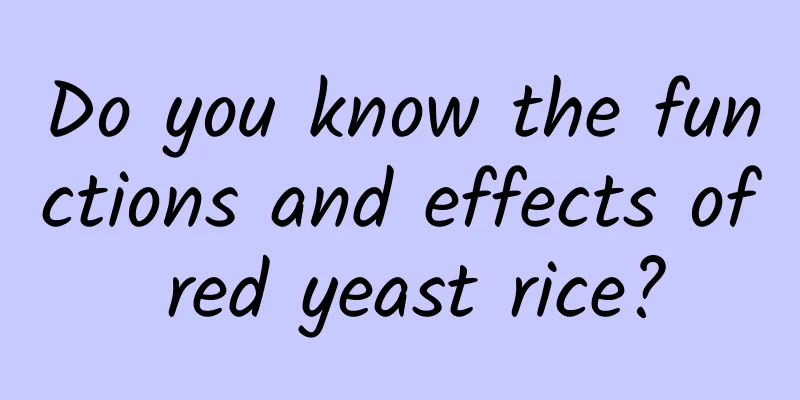Do you know the functions and effects of red yeast rice?

|
As a traditional Chinese medicine, many people don’t know much about red yeast rice. Generally, non-medical professionals don’t know much about traditional Chinese medicine. Therefore, in daily life, people don’t know much about the role and efficacy of this traditional Chinese medicine. When you need to take medicine for an illness, you may find this medicinal material. Then let me introduce to you the effects and functions of red yeast rice! Red yeast rice is the name of a traditional Chinese medicine. Red yeast rice is made by the mycelium of Monascus purpureus Went., a fungus of the Aspergillus family, parasitizing on polished japonica rice. Distributed in Hebei, Jiangxi, Zhejiang, Taiwan, Fujian, Guangdong and other places. It has the effects of strengthening the spleen and digestion, promoting blood circulation and removing blood stasis. It is often used for food stagnation, abdominal distension, red and white diarrhea, postpartum lochia, and trauma. Its functions and effects are mainly as follows: 1. Lower cholesterol: Monalin K produced by Monascus is a cholesterol inhibitor, which can especially lower bad cholesterol, remove fat in the blood and eliminate toxins. 2. Lowering blood sugar: Red yeast rice contains short-chain protein substances that inhibit sugar absorption. 3. Anti-inflammatory: Morinda can inhibit or reduce inflammation when the arterial walls are damaged. 4. Anti-aging: The antioxidant ingredients produced by red yeast rice, such as flavonoids, can eliminate free radicals. 5. Lower blood pressure: Red yeast rice contains GABA, which has the effect of lowering blood pressure. 6. Prevent dementia: Acetylcholine in red yeast rice can calm nerves and improve memory. Coenzyme Q10 can be isolated after red yeast rice fermentation. Coenzyme Q10, also known as decenylquinone, is an activator of cell metabolism and cell respiration. It can improve mitochondrial respiratory function and promote oxidative phosphorylation reactions. It is a natural oxidant produced by the cells themselves, which can inhibit mitochondrial peroxidation and protect the integrity of the biological membrane structure. It has a non-specific enhancing effect on immunity, can increase the phagocytic rate of macrophages, increase the production of antibodies, and improve T cell function. |
<<: The side effects of Sterculia lychnophora, four major hazards should be kept in mind
>>: The famous "cancer-free village" actually relies on this to fight cancer
Recommend
The efficacy and function of the small heron orchid
Small egret orchid is a very common type of tradi...
It has just been announced that the LPR has been lowered, your mortgage may become cheaper!
Mixed Knowledge Specially designed to cure confus...
Pretentious, emotionally unstable? No! Stop scolding! We are just sensitive to order...
We all live with social evaluations and are influ...
Why Cantonese People Can't Eat Fujianese? Prions Have Something to Say
The "food chain" relationship between C...
What changes will happen to your body after falling in love? Some of them you may not even realize...
Expert of this article: Zhao Wei, MD, associate c...
Be alert! A case of plague has been confirmed in a place in China, and the condition is critical!
Ningxia reported in the early morning: A case of ...
The efficacy and function of bilberry leaves
As a traditional Chinese medicine, bilberry leave...
How harmful is it to drink sugary drinks for a long time? Experts give the answer. Do you dare to drink it again after reading this?
Do you usually drink milk tea or other beverages?...
Replica of the "precision eye"! New crystal material can expand the field of view to 360 degrees
Popular Science Times (Intern Wang Yuke) The inte...
Uterine cystic echo
I believe that many people do not know what uteri...
In this case, "running a green light" is also illegal! 丨National Traffic Safety Day
December 2 is the 13th National Traffic Safety Da...
My jaw is swollen and there is a lump that hurts when I press it
Some friends will find that their chin is swollen...
Can Imperata Root Cure Kidney Disease?
Kidney disease is often accompanied by urinary sy...
The efficacy and function of Hudoucao
Hu Dou Cao is a traditional Chinese medicinal mat...
The efficacy and function of croaker
In our lives, croaker has attracted our attention...









